Chem 212 lab 6 - Study guides, Class notes & Summaries
Looking for the best study guides, study notes and summaries about Chem 212 lab 6? On this page you'll find 6 study documents about Chem 212 lab 6.
All 6 results
Sort by
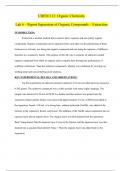
-
CHEM 212 Lab 6 Report Separation of Organic Compounds – Extraction
- Summary • 4 pages • 2023
- Available in package deal
-
- $8.49
- + learn more
CHEM 212 Lab 6 Report Separation of Organic Compounds – Extraction CHEM 212 Lab 6 Report Separation of Organic Compounds – Extraction
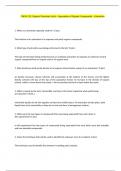
-
CHEM 212: Organic Chemistry Lab 6 Exam Separation of Organic Compounds – Extraction (Verified Answers)
- Exam (elaborations) • 4 pages • 2023
- Available in package deal
-
- $8.49
- + learn more
CHEM 212: Organic Chemistry Lab 6 Exam Separation of Organic Compounds – Extraction (Verified Answers) CHEM 212: Organic Chemistry Lab 6 Exam Separation of Organic Compounds – Extraction (Verified Answers)
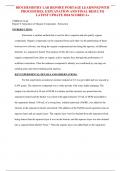
-
BIOCHEMISTRY LAB REPORT 6| PORTAGE LEARNING|WITH PROCEDURES, EXPLANATION AND FINAL RESULTS| LATEST UPDATE 2024 SCORED A+
- Exam (elaborations) • 4 pages • 2024
-
Available in package deal
-
- $10.49
- + learn more
BIOCHEMISTRY LAB REPORT 6| PORTAGE LEARNING|WITH PROCEDURES, EXPLANATION AND FINAL RESULTS| LATEST UPDATE 2024 SCORED A+ CHEM 212 Lab Report 6: Separation of Organic Compounds –Extraction INTRODUCTION: Extraction is another method that is used in lab to separate and also purify organic compounds. Organic compounds can be separated from each other via the partitioning of them between two solvents, one being the organic compound and one being the aqueous, of different densities in a sep...
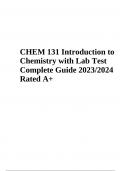
-
CHEM 131: Introduction to Chemistry with Lab Test | Complete Guide 2023 Rated 100%
- Exam (elaborations) • 74 pages • 2023
-
- $25.49
- + learn more
CHEM 131: Introduction to Chemistry with Lab Test | Complete Guide 2023 Rated 100%. What is the volume in mL of a cube of water with dimensions 11.0 cm × 11.0 cm × 11.0 cm ? A.1.33 × 103 B.1.3 × 103 C.1.33 × 10-3 D.1.331 × 10-3 E.none of the above Answer Key: A Feedback: This is discussed in section 2.8 in the text. Question 5 of 12 0.0/ 4.0 Points When the value 98.54 is rounded to two significant figures, the number should be reported as: A.98 B.98.5 C.99 D.100 E.none of t...
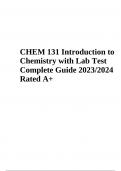
-
CHEM 131 Introduction to Chemistry with Lab Test Complete Guide 2023/2024 Rated A+
- Exam (elaborations) • 74 pages • 2023
-
- $28.49
- + learn more
CHEM 131 Introduction to Chemistry with Lab Test Complete Guide 2023/2024 Rated A+. Who discovered the atomic theory? A.Antoine Lavoisier B.John Dalton C.John Dalton and Antoine Lavoisier D.Albert Einstein E.none of the above Answer Key: B Feedback: Good! It was Dalton. Question 2 of 12 4.0/ 4.0 Points Who discovered the law of conservation of mass? A.Albert Einstein B.John Dalton and Antoine Lavoisier C.Antoine Lavoisier D.John Dalton E.none of the above Answer Key: C Feedback: ...
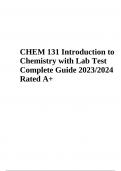
-
Introduction to Chemistry with Lab Test (CHEM 131 ) Guide 2023 Rated A+
- Exam (elaborations) • 74 pages • 2023
-
- $25.49
- + learn more
Introduction to Chemistry with Lab Test (CHEM 131 ) Guide 2023 Rated A+. Given the sequence of temps below, which one represents the Fahrenheit boiling, room temp, and freezing points of water, in that order? A.0-75-100 B.212-75-32 C.0-25-100 D.0-298-373 E.none of the above Answer Key: B Question 7 of 12 0.0/ 4.0 Points `How should someone classify grape juice? A.mixture-homogeneous B.pure substance-compound C.mixture-heterogeneous D.pure substance-element E.none of the above Ans...

Did you know that on average a seller on Stuvia earns $82 per month selling study resources? Hmm, hint, hint. Discover all about earning on Stuvia


